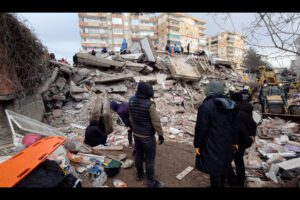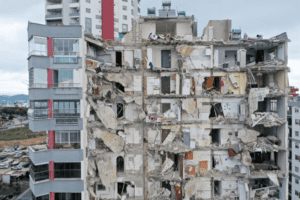
Conserve Energy During Winter
February 6, 2023
Working from Home with Your Dog
March 4, 2023Earthquake Risk is most commonly an excluded peril on Homeowners Insurance and other types of Hazard Insurance policies. The highest risk of devastating earthquake damage is in the Western States. An earthquake is defined as sudden and rapid shaking of the earth caused by the breaking and shifting of rock beneath the earth’s surface. Millions of homes and buildings are at risk for damage from an earthquake, yet approximately 10% of homeowners purchase earthquake insurance.


Earthquake Insurance is considered Specialty Insurance and is either underwritten by Earthquake Insurance Carriers or written by a State Earthquake Authority managed by a partnership of member carriers. In areas of higher risk, coverage is limited and expensive compared to standard home insurance; in areas of relatively low risk, earthquake insurance is very inexpensive.
The goal is to provide great coverage options while saving you money. With customized policy options, homeowners can omit coverage which they don’t wish to purchase. It’s our pleasure to provide an earthquake insurance quote, and there is never an obligation to purchase the insurance; in fact, we leave it completely up to you to follow up with any questions.
THE RISK IS IN THE NUMBERS
The Next Big Quake in the United States will most likely strike in either Washington, Oregon or California. Following the recent 7.8 devastating earthquake in Turkey at the intersection of 3 tectonic plates, it is time for us to keep focused on the risk along the Western Coast of the United States of America.
If you cannot afford the cost of rebuilding or repairing your home after an earthquake, Earthquake Insurance may be the only option to securing your largest investment.
Earthquake insurance
Earthquakes are not covered under standard homeowners or hazard insurance policies. Coverage is available either in the form of an endorsement or as a separate policy for homeowners, hazard, landlord and condo unit owners insurance policies.
Earthquake insurance coverage is available from private insurance companies. Coverage for other kinds of damage that may result from earthquakes, such as fire and water damage due to burst gas and water pipes, is provided by standard home insurance policies in most states.
Insurers that don’t write earthquake insurance may still be impacted by these catastrophes due to losses from fire following a quake.
Deductibles and Costs: Earthquake insurance carries a deductible in the form of a percentage rather than a fixed amount. Deductibles range from 2 1/2 percent to 25 percent of the coverage limit. Premium differs widely by location and the type of structure that is covered; older buildings cost more to insure than new ones. Wood frame structures generally benefit from lower rates than brick buildings because they tend to withstand quake stresses better. California law requires homeowners insurance companies to offer earthquake coverage to their policyholders. Homeowners can decide to purchase it, purchase a policy from another insurer or decline it altogether.
Where do earthquakes occur?
The forces of plate tectonics shape the earth as the huge plates that form the Earth’s surface move slowly over, under, and past each other.
Sometimes the movement is gradual. At some points, the plates are locked together and unable to move; pressure building up grows until the plates break free causing the ground to shake and rupture along fault lines.
One of the most famous faults is the San Andreas Fault, which extends about 600 miles from the Gulf of California northwest along the California coast. The 1906 San Francisco earthquake was caused by movement of the San Andreas Fault.
Quakes can produce different kinds of shaking. Some, like the 6.8 magnitude Northridge quake, are thrust fault quakes, which cause violent up-and-down, rather than the more common side-to-side movement. Ground shaking from earthquakes can collapse buildings and bridges as well as trigger landslides, avalanches, floods, fires, and tsunamis. Buildings with foundations resting on unconsolidated landfill and other unstable soil, and trailers and homes not tied to their foundations are at risk because they can be shaken off their mountings during an earthquake.
According to the U.S. Geological Survey, there are more than three million earthquakes worldwide each year. While the vast majority of those are a magnitude 3.9 or lower, more than 900 earthquakes measure 5.0 or higher each year. About 81 percent of the world’s largest earthquakes occur in the Circum-Pacific seismic belt, more commonly known as the ‘Ring of Fire’. The area extends from Chile, northward along the western South American coast through Central America, Mexico, the west coast of the United States and the southern part of Alaska, through the Aleutian Islands to Japan, the Philippine Islands, New Guinea, the island groups of the Southwest Pacific and to New Zealand.
The most powerful earthquake on record occurred in Chile on May 22, 1960. The magnitude 9.5 quake caused $550 million in damage, killed more than 2,000 people and injured more than 3,000. It also caused a tsunami, which caused additional destruction in Hawaii, Japan, the Philippines and the West coast of the United States.
Highest Earthquake risk in the United States
Although 42 states have a reasonable chance of experiencing a damaging earthquake, the 16 states at highest risk of quakes are Alaska, Arkansas, California, Hawaii, Idaho, Illinois, Kentucky, Missouri, Montana, Nevada, Oregon, South Carolina, Tennessee, Utah, Washington, and Wyoming. The state with the most major earthquakes is Alaska, but the one with the most damaging earthquakes is California.
Earthquake risk in the Western United States: Although the entire Northwest of the United States is at high risk of earthquakes, eight of the 10 costliest earthquakes in the last century occurred in California. According to the U.S. Geological Survey, there is a 72 percent probability that an earthquake of magnitude 6.7 or larger will strike the San Francisco Bay area over the next 30 years.


